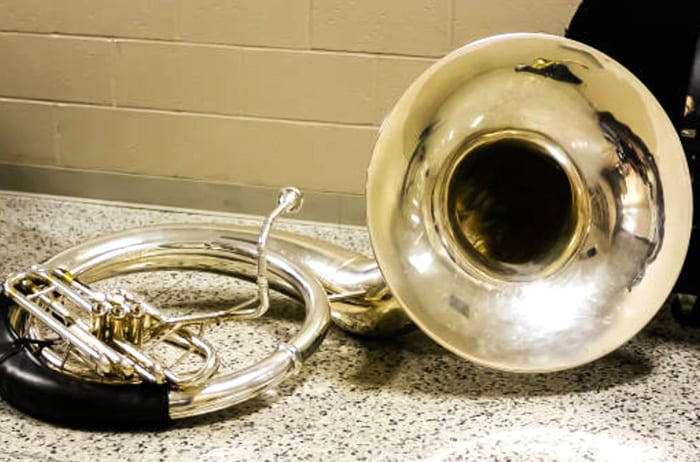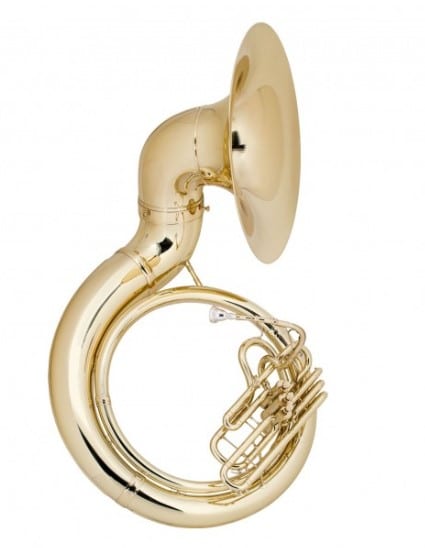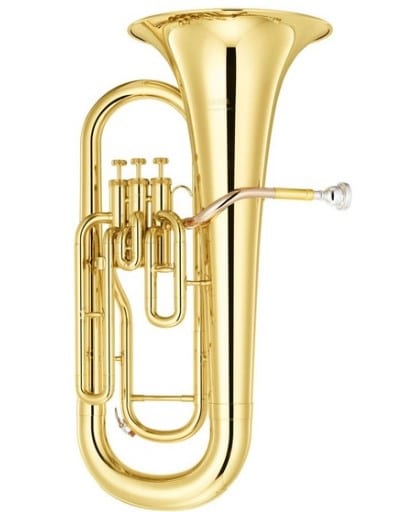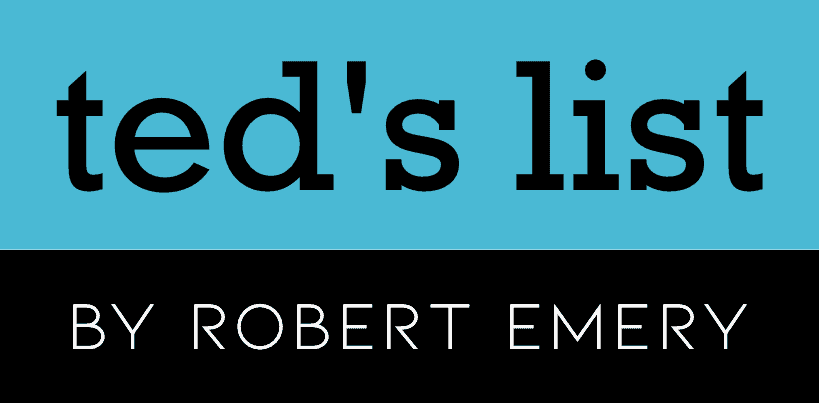Best Beginner
Euphonium
-
Overall: 9/10
-
Best Feature: Lighter weight model
-
TedScore™: 9/10
Best Beginner
Tuba
-
Overall: 9/10
-
Best Feature: Offers a balanced blowing resistance across the entire range
-
TedScore™: 9/10
Best Beginner
Sousaphone
-
Overall: 8.5/10
-
Best Feature: Professional-looking lacquered brass body
-
TedScore™: 8.5/10
Picture yourself walking through a lively brass band festival, and you hear the deep, majestic sounds of the sousaphone, tuba, and euphonium. It’s like they’re having a grand musical conversation, but what makes each unique?
I’m excited to guide you through the differences between the sousaphone vs tuba vs euphonium and why each instrument has its group of fans!
These large brass instruments often need clarification, but did you know that despite their family ties, they play pretty different tunes in an orchestra or a marching band?
Today, I’ll share the mystery of their shapes and sounds and when you’d ideally want to use each. Keep scrolling, and you’ll become the life and ‘soul’ (pun intended!) of your next music-themed trivia night!
Fundamentals of Brass Instruments
When it comes to brass instruments, there are a few fundamental aspects that you should understand. These basic principles apply when playing the tuba, sousaphone, or euphonium.
Buzzing
Valves
Bore
Conical Bore
Length
Pitch
Overview of the Tuba
The tuba is an excellent choice if you’re looking for a brass instrument that produces a deep, rich sound. It’s a popular instrument in orchestras, brass ensembles, and concert bands and is often used in jazz bands.
Tubas come in various sizes, from the small tenor tuba to the massive subcontrabass tuba. The most common types of tubas are the F, BB, and CC tubas, with the F tuba being the smallest and the CC tuba being the largest.
Bass tubas are also popular and come in various keys, including C and Bb.

One of the defining features of the tuba is its large size and weight. The diameter of the bell can range from 14 to 30 inches, and the instrument’s weight can range from 10 to 30 pounds.
This makes the tuba a challenging instrument to transport, but it’s well worth the effort for the rich, warm sound it produces.
When playing the tuba, the mouthpiece is an essential factor to consider. The mouthpiece affects the tonal range and projection of the instrument, so it’s essential to choose the right one for your playing style.
In terms of cost, tubas can be quite expensive, with prices ranging from a few thousand pounds to tens of thousands of pounds. Maintenance is also important, as tubas require regular cleaning and upkeep to keep them in good condition.
Understanding the Sousaphone
If you’re a fan of marching bands, you’ve probably seen the sousaphone. This brass instrument is a popular choice for marching bands due to its unique design, allowing it to be played while carried on the shoulder.
The sousaphone is a member of the tuba family and is often confused with the tuba. However, the sousaphone has a more compact design and a flared bell that faces forward. This allows the sound to project in the direction the band is marching.

Sousaphones are typically made of fibreglass or resin materials, which makes them lightweight and easy to carry. They also feature a rain catcher, which prevents water from entering the instrument during outdoor performances.
Regarding finishes, sousaphones can be plated, lacquered, silver, or gold. The oversized bell is a signature feature of the sousaphone and is often adorned with intricate designs.
The sousaphone is named after John Philip Sousa, the American march king who popularized the instrument in the early 1900s. Sousa believed the tuba was too heavy for marching band use and designed the sousaphone as a more practical alternative.
Insight Into the Euphonium
If you’re looking for a brass instrument that can produce a rich, mellow tone, the euphonium might be just what you’re looking for.
This instrument is a popular choice for both classical and jazz musicians, and it’s often used in concert bands, orchestras, and brass ensembles.
One of the unique features of the euphonium is its valve system. The euphonium typically has four, unlike other brass instruments with only three valves. This allows the player to achieve broader pitches and more complex melodies.
The euphonium is known for its warm, expressive sound, which is why it’s often used in ballads and slow pieces. Its tonal range spans from the low B-flat to the high F, making it a versatile instrument that can be used in various musical genres.

Regarding cost, euphoniums can range from a few hundred for a beginner model to several thousand for a professional-grade instrument. Like all brass instruments, euphoniums require regular maintenance to keep them in good condition.
Comparison Between Tuba, Sousaphone and Euphonium
When it comes to brass instruments, the tuba, sousaphone, and euphonium are often mentioned in the same breath.
While they share some similarities, they also have some key differences that set them apart. Here’s a comparison of the three instruments.
Size and Weight
Bell and Mouthpiece
Sound and Pitch
Valves and Tubing
Best Tubas in the Market
JUPITER JTU1020 Eb TUBA, CLEAR LACQUER

DESIGNED FOR: advancing tuba players
FEATURES: With steel pistons for smooth, fast action
OTHER INFO: Designed to be maintenance-friendly
- Has a professional-looking silver-plated brass body
- Built using state-of-the-art technology
- Suitable for a wide range of musical styles and settings
- Includes hard shell case and mouthpiece
- Relatively heavy and may be difficult to manoeuvre for some players
When you click ‘Check Price’, you’ll see there are loads of great places to buy this item. Our personal favorite is Sweetwater for the US, and Thomann and Gear4Music for the UK & Europe.
They are the largest music retailers, with excellent customer service, competitive prices, really fast shipping, and the longest guarantees.
The professional musician who wrote this article combined many things,
from the product build, manufacturer’s reputation through to feedback
from other users, to create our famous TedScore™.
LEVANTE BY STAGG BT5505 4 VALVE COMPACT Bb TUBA

DESIGNED FOR: intermediate to advanced players
FEATURES: With super fast and accurate rotary valves
OTHER INFO: Has a gold brass leadpipe that produces a sonorous tone
- Made with a gorgeous clear lacquer finish
- Produces smooth and warm tones
- The most cost-effective way of playing the rotary tuba
- Includes a case with wheels and mouthpiece
- May not have the same level of durability and longevity as more expensive professional models
When you click ‘Check Price’, you’ll see there are loads of great places to buy this item. Our personal favorite is Sweetwater for the US, and Thomann and Gear4Music for the UK & Europe.
They are the largest music retailers, with excellent customer service, competitive prices, really fast shipping, and the longest guarantees.
The professional musician who wrote this article combined many things,
from the product build, manufacturer’s reputation through to feedback
from other users, to create our famous TedScore™.
Top 3 Sousaphones
Best For RELIABLE AND DURABLE CONSTRUCTION
Jupiter JSP1000B Sousaphone, Lacquered

FEATURES:
The Fiberglass body is lightweight and durable
- Stainless steel pistons for smooth, fast action
- Professional-looking lacquered brass body
- Service friendly design
- Includes soft case and mouthpiece
- More expensive than some other beginner sousaphones on the market
When you click ‘Check Price’, you’ll see there are loads of great places to buy this item. Our personal favorite is Sweetwater for the US, and Thomann and Gear4Music for the UK & Europe.
They are the largest music retailers, with excellent customer service, competitive prices, really fast shipping, and the longest guarantees.
The professional musician who wrote this article combined many things,
from the product build, manufacturer’s reputation through to feedback
from other users, to create our famous TedScore™.
Best For LONG-LASTING DURABILITY
King 20KW Sousaphone, Lacquer

FEATURES:
-Large bore for a full sound, perfect for marching bands
- Nickel silver pistons offer smooth action and a quick response
- With improved bracing for added durability
- Comes with moulded plastic case
- Very expensive
When you click ‘Check Price’, you’ll see there are loads of great places to buy this item. Our personal favorite is Sweetwater for the US, and Thomann and Gear4Music for the UK & Europe.
They are the largest music retailers, with excellent customer service, competitive prices, really fast shipping, and the longest guarantees.
The professional musician who wrote this article combined many things,
from the product build, manufacturer’s reputation through to feedback
from other users, to create our famous TedScore™.
Best For EASY PLAYABILITY
Coppergate Fibreglass Bb Sousaphone by Gear4music

FEATURES:
- Three stainless steel valves, fibreglass bell
- Lightweight fibreglass sousaphone
- Budget-friendly sousaphone
- Creates an authentic and rich tone
- May not be as durable as more expensive brands
When you click ‘Check Price’, you’ll see there are loads of great places to buy this item. Our personal favorite is Sweetwater for the US, and Thomann and Gear4Music for the UK & Europe.
They are the largest music retailers, with excellent customer service, competitive prices, really fast shipping, and the longest guarantees.
The professional musician who wrote this article combined many things,
from the product build, manufacturer’s reputation through to feedback
from other users, to create our famous TedScore™.
Recommended Euphoniums
Yamaha YEP201 Student Euphonium, Gold

FEATURES:
- Crisp, warm tone and balanced resistance throughout the range
- Carefully designed valve system for perfect intonation
- Lighter weight model
- Tonal colours perfect for ensemble and solo performances
- Includes a Yamaha mouthpiece and sturdy case
- Provides a free five-year extended warranty upon purchase
- The instrument's gold finish may be prone to scratches and wear
When you click ‘Check Price’, you’ll see there are loads of great places to buy this item. Our personal favorite is Sweetwater for the US, and Thomann and Gear4Music for the UK & Europe.
They are the largest music retailers, with excellent customer service, competitive prices, really fast shipping, and the longest guarantees.
The professional musician who wrote this article combined many things,
from the product build, manufacturer’s reputation through to feedback
from other users, to create our famous TedScore™.
Conn-Selmer 300EH Euphonium, Silver Plate with Trigger

FEATURES:
-Comes equipped with a professional-style tuning trigger for precision tuning
-Boasts a stunning silver plate with a gold trim finish for a stylish look
-The rose brass lead pipe produces a rich, sonorous sound that is sure to impress
- Comes with a mouthpiece and lightweight cast with wheels for easy transportation
- The four-valve, fully compensating system is perfect for rapid skill development
- More expensive than some other intermediate-level euphoniums available
When you click ‘Check Price’, you’ll see there are loads of great places to buy this item. Our personal favorite is Sweetwater for the US, and Thomann and Gear4Music for the UK & Europe.
They are the largest music retailers, with excellent customer service, competitive prices, really fast shipping, and the longest guarantees.
The professional musician who wrote this article combined many things,
from the product build, manufacturer’s reputation through to feedback
from other users, to create our famous TedScore™.
Jupiter JEP1120 Performers Euphonium, Clear Lacquer

FEATURES:
-The instrument's tone blends seamlessly with a brass band for a harmonious sound
-Constructed using cutting-edge technology for superior quality
-The rose brass lead pipe produces a warm, resonant tone that is sure to impress
- Comes with a hardshell case and mouthpiece for added convenience
- Specifically designed to meet the needs of advanced players
- A relatively heavy instrument, which may be uncomfortable for some players
- Quite expensive for an intermediate-level instrument
When you click ‘Check Price’, you’ll see there are loads of great places to buy this item. Our personal favorite is Sweetwater for the US, and Thomann and Gear4Music for the UK & Europe.
They are the largest music retailers, with excellent customer service, competitive prices, really fast shipping, and the longest guarantees.
The professional musician who wrote this article combined many things,
from the product build, manufacturer’s reputation through to feedback
from other users, to create our famous TedScore™.
Tuba Vs Sousaphone Vs Euphonium: A Recap
Summary
I’ve enjoyed discussing the differences between tubas, sousaphones, and euphoniums. Who knew brass could be so diverse and exciting?
A tuba sits comfortably with the player, often the backbone of an orchestra with deep and resonant tones. Now, the sousaphone – the life of a marching band- is crafted to be wearable and robust for all those fancy footwork occasions. With its higher range and lyrical voice, the euphonium often steals the show in concert bands.
Here’s a quick recap that’ll stick in your mind like the catchy tune of a brass band:
- Tuba: The orchestra’s giant – thinks sitting is the new standing.
- Sousaphone: Wraps around you like a musical hug – always ready to march.
- Euphonium: The charming cousin with a flair for melody.
In the end, whether you’re playing to an audience from a chair or marching in a parade, there’s a brass instrument waiting for you. Each has found its place, holding a particular spot in the hearts of musicians and audiences!
I like to think of them as the Three Musketeers of the brass world – all for one and one for all in creating majestic music that resonates through the soul. Off you go, brave musical adventurer, to find your brass counterpart!
Before you go…
Brace yourself for more brass-tastic fun! Check out the next post as we dive into the Tuba vs Trombone.
Get ready to discover some hidden gems in the world of brass music












Robert Emery, your comprehensive outline and analysis of brass instruments, particularly the tuba, sousaphone, and euphonium, have caught my attention. Your discussion on the fundamentals of brass instruments provides a solid foundation for beginners and enthusiasts alike. I am curious about the criteria you used to select the ‘Best Tubas in the Market’ and ‘Recommended Euphoniums.’ Could you shed more light on the selection process, including any specific features or characteristics that were prioritized? It would be fascinating to understand how certain instruments stood out from the rest in terms of reliability, durability, and ease of playability.
sousaphones rock in marching bands. they look cool and sound awesome. that’s all.
What a comprehensive and informative piece on brass instruments! I found the section on the differences in bore particularly insightful. It’s interesting to see how these variations can impact the sound and playability of the instrument. I also appreciated the concise yet thorough comparison between the tuba, sousaphone, and euphonium. These details are often glossed over in introductory music classes. Robert Emery, your article will undoubtedly be a resource I return to throughout my studies. I’m eager to share this with my fellow students and instructors.
Great article! Just started learning tuba and this helps a lot. Thanks!
This is gold! Planning to use this article for my next class discussion on brass instruments. Very well written and easy to understand. Thanks, Robert Emery!
While I appreciate your coverage on these instruments, I have to say, comparing a tuba to a sousaphone based solely on size, weight, and bell size overlooks their contextual uses and cultural significance. For instance, the sousaphone, with its design, is more suited for marching bands, allowing greater mobility and forward projection of sound. The tuba, on the other hand, is often seen anchoring the brass section in orchestras. Each instrument has a unique role that goes beyond their physical attributes.
lol didn’t even know what a euphonium was before this.
I gotta say, I’m always a bit wary when articles claim to list the ‘best’ of anything. Who decides what’s best? Is it about quality, price, durability…? How did you decide, Robert Emery?
Interesting read, Robert Emery, especially on the tuba’s overview. However, I believe there’s a slight inaccuracy in the historic development section of the tuba; the first tuba was actually patented in 1835, not 1838. Additionally, the origins of the sousaphone’s design you’ve mentioned could benefit from a mention of John Philip Sousa’s role in its development, which was quite significant.
this was cool to read even tho im mostly a sax guy. brass seems complicated but interesting. maybe i’ll try the euphonium?